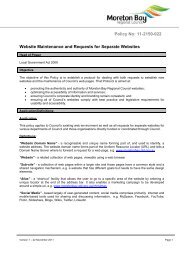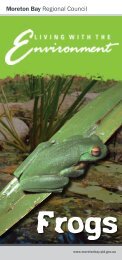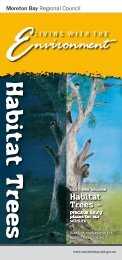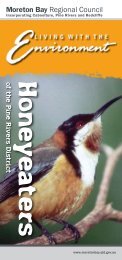Lantana - Moreton Bay Regional Council
Lantana - Moreton Bay Regional Council
Lantana - Moreton Bay Regional Council
- No tags were found...
You also want an ePaper? Increase the reach of your titles
YUMPU automatically turns print PDFs into web optimized ePapers that Google loves.
Fact sheetDECLARED CLASS 3 PEST PLANT<strong>Lantana</strong><strong>Lantana</strong> camaraCurrently, lantana covers more than 5 million ha of theeast coast from southern New South Wales to Far NorthQueensland. Small infestations of lantana have also beenfound in central west Queensland, the Northern Territory,Western Australia, South Australia and Victoria. Efforts areunder way to control these.<strong>Lantana</strong> is mainly spread by people (as ornamental plants)and fruit-eating birds. It forms dense thickets that smotherand kill native vegetation and are impenetrable to animals,people and vehicles.Research indicates more than 1400 native species arenegatively affected by lantana invasion, including manyendangered and threatened species. As lantana is a woodyshrub that has thin, combustible canes, its presence canalso create hotter bushfires.Declaration detailsAll lantana species are declared Class 3 plants under theLand Protection (Pest and Stock Route Management) Act2002. <strong>Lantana</strong> species cannot be sold or distributed andlandholders may be required to control these plants if theypose a threat to an environmentally significant area.Description and general information<strong>Lantana</strong> is a heavily branched shrub that can grow incompact clumps, dense thickets or as a climbing vine.The stems are square in cross section, with small,recurved prickles. Most leaves are about 6 cm long andare covered in fine hairs. They are bright green above,paler beneath and have round-toothed edges. Leaves growopposite one another along the stem. When crushed theleaves produce a distinctive odour.Flowers appear throughout most of the year in clustered,compact heads about 2.5 cm in diameter. Flower coloursvary from pale cream to yellow, white, pink, orange andred. <strong>Lantana</strong> produces round, berry-like fruit that turn fromglossy green to purplish-black when ripe.For rural producers, lantana poses problems of stockpoisoning and invasion of desirable pasture. Aneconomic impact assessment indicated lantana coststhe Queensland grazing sector in excess of $70 million(2005–06 values) per year.It is now illegal to sell ordistribute any variety of lantana in Queensland. However,garden plantings are still common in many areas and havethe potential to cause problems of their own.PP34 January 2011
Despite being sold and marketed as ‘sterile’ plants,research indicates some ornamental lantana varieties havethe ability to set seed and can spread vegetatively. Theyalso produce some viable pollen and have the potential tocross-pollinate with wild forms, creating new varieties thatcould naturalise in the environment.If the number of naturalised varieties increases due togenetic drift from ornamental varieties it will make findingeffective biological control agents even more difficult, andpotentially extend the climatic tolerances and range of theweed’s spread.Habitat and distribution<strong>Lantana</strong> is native to the tropical and subtropical regions ofCentral and South America.It is found throughout most coastal and subcoastalareas of eastern Australia, from Far North Queenslandto southern New South Wales. It grows in a wide varietyof habitats, from exposed dry hillsides to wet, heavilyshaded gullies.ToxicityMany lantana varieties are poisonous to stock. It is difficultto tell which varieties are toxic so it is better to treat allforms as potentially poisonous. The toxins in lantanainclude the triterpene acids, lantadene A (rehmannic acid),lantadene B, and their reduced forms.Most cases of lantana poisoning occur when new stockare introduced into lantana-infested areas. Stock bred onlantana-infested country avoid lantana unless forced toeat it due to lack of other fodder. Young animals introducedto lantana areas are most at risk.Symptoms of lantana poisoning depend on the quantity andtype of lantana consumed and, under some circumstances,the intensity of light to which the animals are exposed.Early symptoms of depression are noticeable, with headswaying, loss of appetite, constipation and frequenturination. After a day or two the eyes and the skin of thenose and mouth start yellowing with jaundice, and themuzzle becomes dry and warm. The eyes may becomeinflamed and have a slight discharge. The animal alsobecomes increasingly sensitive to light. Finally, the muzzlebecomes inflamed, moist and very painful (‘pink nose’).Areas of skin may peel and slough off. Death commonlyoccurs 1-4 weeks after symptoms occur. Death from acutepoisoning can occur 3-4 days after eating the plant.If animals show any of the early symptoms, they shouldbe moved to lantana-free areas, kept in the shade andmonitored. Veterinary treatment should be soughtimmediately. Some remedies may include intravenousfluids, treating skin damage with antibiotics, or drenchingwith an activated charcoal slurry.Care should be taken when introducing new or younganimals into a paddock if lantana is present. Ensurethey have enough fodder to stop them eating lantana inquantities sufficient to result in poisoning. During drought,animals should not be placed in lantana-infested areaswithout alternative food.ControlUsing a mix (integration) of control methods gives thebest results. Size, density and geographic location ofinfestations are important considerations for choosingwhich control methods to use. A general principle is tocommence control programs in areas of light infestationsand work towards the denser infestations.For large lantana infestations, treatment with herbicidesby foliar spraying is usually not economically feasible.However, fire, dozing/stick raking, slashing/cutting,aerial helicopter spraying can reduce dense infestations,making follow-up spot treatments with chemicals moreeconomically viable.<strong>Lantana</strong> seed banks remain viable for at least four years,so follow-up control to kill seedlings before they matureis vital to ensure initial management efforts to control theparent bush are not wasted.Appropriate fire regimes may become part of amanagement program to ensure lantana invasiveness isreduced and pasture is maintained.Removal of lantana within areas of remnant vegetationmay require a permit under the Vegetation ManagementAct 1999. Further information should be sought from theDepartment of Environment and Resource Managementbefore works commence.Mechanical controlStick raking or ploughing can be effective in removingstanding plants. However, regrowth from stumps and/or increased seedling germination in disturbed soil iscommon and the site will require follow-up treatment.Grubbing of small infestations—for example, along fencelines—can be a useful and effective method of removingplants, though this is time consuming.Repeated slashing can also reduce the vigour of lantana,exhausting its stored resources and reducing its likelihoodof re-shooting.Some locations—for example, very steep inclines or gullies—are not suitable for mechanical control options because ofthe danger of overturning machinery and soil erosion.2 <strong>Lantana</strong> <strong>Lantana</strong> camara
FireRegular burning will reduce the capacity of plants tosurvive; however, initial kill rates are variable.The effectiveness of this method will depend onthe suitability of available fuel loads, fire intensity,temperature, relative humidity, soil moisture and season.Pasture re-establishment can then provide competition toinhibit lantana seed germination.Fire is not recommended in non–fire tolerant vegetatedareas such as rainforest, or wooded or plantation areas.A typical control program for fire may include:• exclude stock to establish a pasture fuel load• burning (may require a permit)• sow improved pastures—consult your local BiosecurityQueensland officer for advice• continue to exclude stock until pasture has establishedand seeded• burn again in summer before rain and spot spraylantana regrowth when > 0.5 m high and when it isactively growing (see Table 1).Herbicide controlHerbicide recommendations for lantana are shown in Table1. Users of herbicides have a legal obligation to readherbicide labels and use only the registered rates. Alwaysuse herbicides responsibly; adhere to legislation andsafety requirements.Variation in results can be a result of inconsistent applicationmethods, mix rates or seasonal variation. Red-floweredand pink-edged red-flowered lantana are often consideredthe most difficult to control because their leaves are oftensmaller and tougher. However, herbicides can kill thesevarieties if you carefully follow application procedures.For single-stemmed lantana, basal bark spraying and cutstump methods also give good results at any time of year(but best when the plant is actively growing). On multistemmedvarieties, you will obtain best results by carefullyapplying herbicide to each stem.When treating actively growing plants less than 2 mhigh, overall spraying of foliage to the point of run-off isrecommended. Splatter gun techniques are also effectiveand particularly useful in hard-to-access areas. This is bestdone in autumn—when sap flows draw the poison down intothe root stock, but before night temperatures get too cold.Remove grazing animals from spray areas during and soonafter treatment. Stress can cause increased sugar levels inthe leaves of lantana plants, making them more palatable.Landholders and contractors should check if the propertyis situated in a hazardous area. This prevents the use ofsome chemicals, as defined in the Agricultural ChemicalsDistribution Control Act 1966.Biological controlSince 1914, 31 biological control agents have beenintroduced into Australia in an attempt to control lantana.Seventeen have established, of which several insectspecies cause seasonal damage, reducing the vigour andcompetitiveness of lantana in some areas.Biosecurity Queensland research programs continue toinvestigate agents suitable for release in Australia, andtest the viability of these agents in an effort to identifymore effective biological control agents.It is important to remember that biological controlalone should not be relied upon for managing lantanainfestations. Consideration should be given to otheravailable control techniques.The four most important biological control agents are:• sap-sucking bug (Teleonemia scrupulosa)Found in dry areas from Cooktown to Wollongong, thissmall, mottled, bug feeds on the underside of leaves,growing tips and flower buds, causing the leaves todrop early and stopping the plant from flowering.• leaf-mining beetle (Uroplata girardi)Found in most lantana infestations from CapeTribulation to Sydney as well as around Darwin, exceptin very dry or high altitude areas. The adult beetles aredark brown. They shelter in curled leaves and feed onthe upper leaf surfaces. Larvae feed in leaves causingblotches to spread across the leaf. This beetle reducesplant vigour and can suppress flowering.• leaf-mining beetle (Octotoma scabripennis)Found in most lantana infestations from Atherton toWollongong. Adults of this species feed on the upperleaf surface, while larvae feed and mine the centre ofthe leaf and cause blotches. This activity reduces plantvigour and can suppress flowering.• seed-feeding fly (Ophiomyia lantanae)Found from Cape Tribulation to Eden in New South Walesand also around Darwin and Perth. Ophiomyia is a smallblack fly that feeds on flowers and lays eggs on the greenfruits. The maggots of the fly eat the seed and make thefruit unattractive to birds, reducing seed spread.Other agents such as Aconophora compressa (a stemsuckingbug) and Leptobyrsa decora (a sap-sucking bug)have caused some damage in specific geographic areas.Note: Landholders are advised not to consume their timecollecting established insects for distribution. Due to theirown ability to disperse, these insects will be periodically/seasonally present in areas that are climatically suitablefor them.Further informationFurther information is available from your localgovernment office, or by contacting BiosecurityQueensland (call 13 25 23 or visit our website atwww.biosecurity.qld.gov.au).3 <strong>Lantana</strong> <strong>Lantana</strong> camara
Table 1. Herbicides for control of lantanaMethod of application: active Rate Optimum time b Remarksingredient (trade name) aFoliar (overall) sprayFluroxypyr (Starane® 200)Glyphosate (Roundup® 360,Glyphosate 360®)0.5 L to1 L/100 L waterDecember to AprilThorough wetting of plants is required, higher rateshould be used for larger plants1 L/100 L water October to April Wet plant thoroughly. Glyphosate affects any greenplant it comes into contact with. Glyphosate is availablein a range of strengthsPicloram + 2,4-D (Tordon® 75-D) 0.65 L/100 L water February to April Wet plant thoroughly. Legumes are affected if sprayedDichlorprop (<strong>Lantana</strong>® 600) 0.5 L/100 L water December to April Must thoroughly wet all leaves. Please refer to productlabel for situation detailsPicloram + triclopyr +aminopyralid (Grazon Extra®)0.35 L to0.5 L/100 L waterFebruary to AprilWet plant thoroughly. Use the higher rate on largerplants. Legumes may be affected if sprayed2,4-D amine (Amicide® 625) 0.32 L/100 L water March to May Red-flowered lantanas are more resistant to 2,4-D.Will kill young legumesMetsulfuron methyl,(Brush-off®, Brushkiller®600,Lynx® 600)Metsulfuron methyl+ glyphosate (Cutout®)Metsulfuron methyl+ glyphosate (Trounce®)Aminopyralid + fluroxypyr(Hotshot®)(i) Basal bark(ii) Cut stump10 g/100 L water b March to May Results variable. Not found effective in tropics.Follow-up sprays are necessary95 g/100 L water March to May Apply to bushes up to 2 m tall. Spray to thoroughly wet allfoliage and stems. Spray to penetrate throughout the bush173 g/100 L water March to May Apply when actively growing. Do not apply duringperiods of stress0.5 L to0.7 L/100 L waterOctober to AprilTriclopyr (Garlon 600®) 1 L/60 L diesel Any time. Best resultswhen actively growing2,4-D ester(AF Rubber Vine Spray®)Picloram + Triclopyr (Access®) 1 L/60 L dieselPicloram(Vigilant® Herbicide Gel)Glyphosate (Roundup®,Weedmaster Duo®)Splatter gunGlyphosate (Roundup® 360)Metsulfuron methyl(Brushkiller® 600, Lynx® 600)AerialPicloram + triclopyr + 2,4-D(Grazon® DS + 2,4-D amine625 g/L)2.5 L/100 L diesel Any time. Best resultswhen actively growingAny time. Best resultswhen actively growing3 mm to 5 mm gel Any time. Best resultswhen actively growingNeatAny time. Best resultswhen actively growingSpray all foliage, including stems, to the point of run-off(i) Apply to lower 40 cm of every stem. Must ensurecomplete coverage around stem(ii) Cut close to ground level. Immediately apply herbicideAs aboveAs above(ii) If diameter of stump is > 20 mm, use a minimum of5 mm gel thicknessOff-label permit1:9 glyphosate October to April 2 x 2 ml dose per 0.5 m height of lantana+water2 g/L water March to May As above1.5 L + 6 L/haor10 L/ha (Grazon®)When plant activelygrowingHelicopter only. Minimum of 200 L water per hectare.Follow-up re-spray will be required. Do not burn withinsix months of treatmentDichlorprop(<strong>Lantana</strong>® 600) 6 L to 8 L L/ha When plant actively As abovegrowinga Only some common trade names provided.b Optimum times are only a guide. <strong>Lantana</strong> must be actively growing for the herbicide to work.® = Registered trade name.Labels often recommend the additional use of a wetting agent or surfactant within the mix. Herbicides types vary in their selectivity against other species and soil residual.Fact sheets are available from Department of Employment, Economic Development and Innovation (DEEDI) service centres and our Customer Service Centre (telephone13 25 23). Check our website at www.biosecurity.qld.gov.au to ensure you have the latest version of this fact sheet. The control methods referred to in this fact sheetshould be used in accordance with the restrictions (federal and state legislation, and local government laws) directly or indirectly related to each control method. Theserestrictions may prevent the use of one or more of the methods referred to, depending on individual circumstances. While every care is taken to ensure the accuracy ofthis information, DEEDI does not invite reliance upon it, nor accept responsibility for any loss or damage caused by actions based on it.© The State of Queensland, Department of Employment, Economic Development and Innovation, 2011.4 <strong>Lantana</strong> <strong>Lantana</strong> camaraPR11–5584



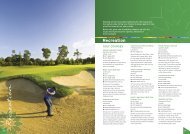

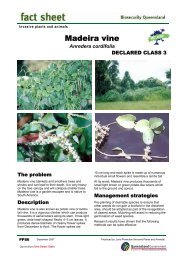
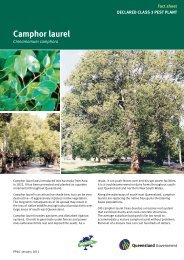


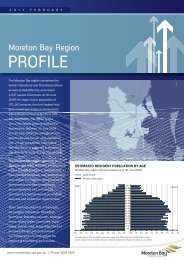
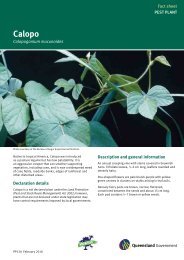
![Kumbartcho Brochure [PDF 540KB] - Moreton Bay Regional Council](https://img.yumpu.com/47220970/1/190x101/kumbartcho-brochure-pdf-540kb-moreton-bay-regional-council.jpg?quality=85)
